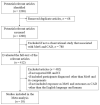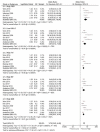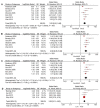Metabolic Syndrome and Coronary Artery Disease Risk: A Meta-Analysis of Observational Studies
- PMID: 33670349
- PMCID: PMC7918238
- DOI: 10.3390/ijerph18041773
Metabolic Syndrome and Coronary Artery Disease Risk: A Meta-Analysis of Observational Studies
Abstract
Although numerous studies have described the link between metabolic syndrome (MetS) and Coronary Artery Disease (CAD), no meta-analysis has been carried out on this relationship. Thus, the present study intended to address this limitation. A systematic search was carried out using electronic databases, such as PubMed, CINAHL Plus, Medline, and Web of Science. A sum of 10 studies (n = 9327) was incorporated in the meta-analysis. Compared with non-MetS, MetS was significantly associated with high CAD risk (OR = 4.03, 95% CI = 3.56-4.56). The MetS components were also significantly correlated with high CAD risk (OR = 3.72, 95% CI = 3.22-4.40). The presence of two (OR = 3.93, 95% CI = 2.81-5.49), three (OR = 4.09, 95% CI = 2.85-5.86), four (OR = 4.04, 95% CI = 2.83-5.78), or all five MetS components (OR = 3.92, 95% CI = 3.11-4.93), were significantly associated with a high risk of CAD. MetS and its individual or combined elements were linked with high CAD risk based on contemporary evidence. Thus, the assessment of MetS and its components might help identify people at a higher risk of advancing CAD in the future.
Keywords: CAD; MetS; cardiovascular disease (CVD); coronary artery disease; metabolic syndrome.
Conflict of interest statement
The authors declare no conflict of interest.
Figures







References
-
- Alberti K., Eckel R.H., Grundy S.M., Zimmet P.Z., Cleeman J.I., Donato K.A., Fruchart J.-C., James W.P.T., Loria C.M., Smith S.C., Jr. Harmonizing the metabolic syndrome: A joint interim statement of the international diabetes federation task force on epidemiology and prevention; national heart, lung, and blood institute; American heart association; world heart federation; international atherosclerosis society; and international association for the study of obesity. Circulation. 2009;120:1640–1645. - PubMed
Publication types
MeSH terms
LinkOut - more resources
Full Text Sources
Other Literature Sources
Medical
Miscellaneous

